이 기사에서는 가공 프로세스에 대해 설명합니다. (선회, 갈기, 마무리 손질), 도구, CNC 가공 알루미늄 및 알루미늄 합금과 관련된 매개변수 및 과제. 또한 CNC 가공에 가장 일반적으로 사용되는 알루미늄 및 합금의 특성을 분석합니다., 뿐만 아니라 다양한 산업 분야에서의 적용 분야.
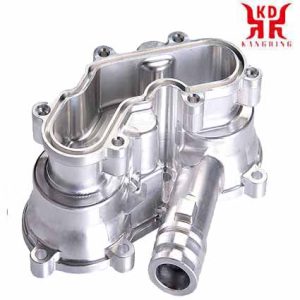
Rapid prototyping of aluminum alloy parts
If you are interested in CNC machining aluminum, you can request a quote for your parts here.
Aluminum is one of the most widely used materials today. 사실은, 알루미늄은 CNC 가공에 사용되는 빈도 측면에서 강철보다 우수합니다.. 이는 주로 알루미늄의 가공성이 우수하기 때문입니다..
순수한 형태로, 화학 원소 알루미늄은 부드럽습니다, 온순한, 비자성이며 은백색 외관을 가짐. 하지만, 알루미늄이라는 원소는 순수한 형태로만 사용되는 것이 아닙니다.. 알루미늄은 일반적으로 망간과 같은 다양한 원소와 함께 사용됩니다., 구리와 마그네슘을 사용하여 수백 가지의 다양한 알루미늄 합금을 생산합니다., 속성이 크게 향상되었습니다.. 가장 일반적인 알루미늄 합금과 다양한 표준의 해당 명칭은 여기에서 확인할 수 있습니다..
수치 1: 순수 알루미늄
CNC 가공 부품에 알루미늄을 사용하면 얻을 수 있는 이점
다양한 특성을 지닌 다양한 알루미늄 합금이 있지만, 모든 알루미늄 합금은 동일한 필수 특성을 가지고 있습니다..
Machinability
Aluminum can be shaped and machined using a variety of different methods. It can be cut quickly and easily with the help of processing machines because it is soft and has high machinability. It is also cheaper than steel and requires less machining. These properties are of great benefit to the cutting machine operator and the customer. 게다가, aluminum is less deformed during machining due to its high machinability. This leads to higher accuracy, as CNC machines can achieve higher tolerances.
Strength to weight ratio
The density of aluminum is about a third of the density of steel. So aluminum is relatively light. Despite its low weight, aluminum is very strong. This combination of high strength and low weight is described by the strength-to-weight ratio. 알루미늄은 중량 대비 강도가 높기 때문에 다양한 산업 분야의 부품에 유리한 소재입니다., 자동차, 항공우주 산업 등.
내식성
알루미늄은 일반적인 해양 및 대기 조건에서 긁힘과 부식에 강합니다.. 이러한 특성은 아노다이징을 통해 향상될 수 있습니다.. 주목해야 할 점, 하지만, 알루미늄의 종류에 따라 내식성이 다르다는 것. 하지만, CNC 가공에 사용되는 가장 일반적인 유형의 알루미늄은 저항이 가장 높습니다..
저온에서의 행동
대부분의 재료는 영하의 온도에서 유익한 특성 중 일부를 잃는 경향이 있습니다.. 예를 들어, 탄소강과 고무는 모두 저온에서 부서지기 쉽습니다.. 대조적으로, 알루미늄은 부드러움을 유지합니다, 매우 낮은 온도에서도 가단성이 있고 강함.
전기 전도도
The electrical conductivity of pure aluminum at room temperature is 36.7 million Siemens per meter. Although aluminum alloys can have lower conductivities than pure aluminum, they are conductive enough to be used as electrical components. 반면에, aluminum is unsuitable if a high electrical conductivity of the manufactured component is undesirable.
Recyclability
Since CNC machining is a subtractive manufacturing process, a lot of chips and therefore a lot of material waste occur during machining. Aluminum is well suited for recycling, 즉. relatively little energy, effort and costs are required to recycle aluminum. This also makes it an advantageous material in terms of avoiding waste of material. This also makes aluminum a more environmentally friendly material in CNC machining.
Anodizing
The anodizing process is a surface finishing process that improves the wear resistance and corrosion resistance of a material. Aluminum is suitable for the anodizing process. This process also makes it easier to color the manufactured aluminum components.
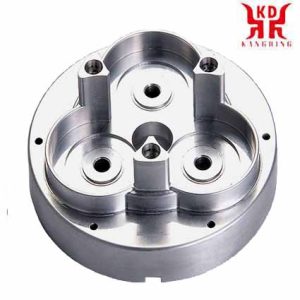
알루미늄 부품의 CNC 밀링
Popular aluminum alloys for CNC machining
In our experience, the following 5 types of aluminum are most commonly used in CNC machining.
EN AW 2007
Alternative names: 3.1645; EN 573-3; AlCu4PbMgMn.
This aluminum alloy contains copper as the main alloying element (4-5% 구리). It is a short-chip alloy that is light, durable, highly functional and has the same mechanical properties as AW 2030. It is also suitable for thread cutting, heat treatment and high speed machining. All these properties make EN AW 2007 a widely used material in the manufacture of components, 볼트, 나사, nuts, rivets and threaded rods. 하지만, 이 유형의 알루미늄은 용접성과 내식성이 좋지 않습니다.; 따라서 부품을 제조한 후에는 보호 양극 산화 처리를 사용하는 것이 좋습니다..
EN AW 5083
Alternative names: 3.3547; 합금 5083; EN 573-3; 미국 A95083; ASTM B209; AlMg4.5Mn0.7
AW 5083 가혹한 조건에서도 탁월한 성능을 발휘하는 것으로 알려져 있습니다.. 마그네슘과 미량의 크롬 및 망간이 포함되어 있습니다.. 이 품종은 화학 및 해양 환경에서 부식에 대한 저항성이 매우 높습니다.. AW 5080 비열처리 합금 중 강도가 가장 높습니다.; 용접 후에도 받는 성질. 이 합금은 위의 온도에서 사용해서는 안 되지만 65 ℃, 저온 응용 분야에서 탁월한 성능을 발휘합니다..
다양한 유익한 특성으로 인해, AW 5080 극저온 시스템을 포함한 다양한 응용 분야에 사용됩니다., 해양 응용, 압력 시스템, 화학 응용, 용접 구조물 및 차체.
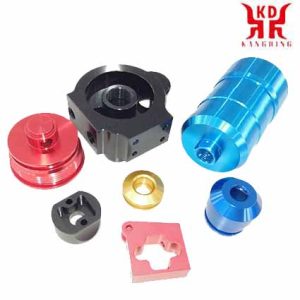
알루미늄 합금 부품의 표면 마무리
EN AW 5754
Alternative names: 3.3535; 합금 5754; EN 573-3; U21NS A95754; ASTM B 209; Al-Mg3.
알루미늄 함량이 가장 높은 알루미늄-마그네슘 혼련재료, AW 5754 굴릴 수 있다, 단조 및 압출. 열처리가 불가능하며 성형성을 희생하여 강도를 높이기 위해 냉간 가공할 수 있습니다.. 게다가, 이 합금은 내식성이 우수하고 강도가 높습니다.. 이러한 속성을 사용하면, AW는 놀라운 일이 아닙니다. 5754 CNC 가공에서 가장 널리 사용되는 알루미늄 유형 중 하나입니다.. 일반적으로 용접구조물에 사용됩니다., 바닥, 낚시 장비, 차체, 리벳, 그리고 식품 가공에서.
EN AW 6061
Alternative names: 3.3206; ISO 6361; 미국 A96060; ASTM B 221; AlMgSi0.5
마그네슘과 실리콘을 함유한 단조 합금입니다.. 열처리가 가능하며 평균 강도를 갖습니다., 용접성이 좋고 성형성이 좋다.. 게다가, 그것은 매우 높은 내식성을 가지고 있습니다.; 아노다이징을 통해 개선할 수 있는 특성. EN AW 6060 건축에 널리 사용됩니다, 식품 가공, 의료기술과 자동차기술.
EN AW 7075
Alternative names: 3.4365; UNS A96082; H30; Al-Zn6MgCu.
이 유형의 알루미늄의 주요 합금 원소는 아연입니다.. EN AW이지만 7075 평균적인 가공성을 가지고 있습니다, 냉간 성형성이 좋지 않아 용접이나 브레이징에 적합하지 않습니다., 그것은 높은 강도 대 무게 비율을 가지고 있습니다., 대기 및 해양 환경에 대한 탁월한 내성, 일부 강철 합금에 필적하는 강도. 이 합금은 매우 광범위한 응용 분야에 사용됩니다. – 행글라이더에서, 자전거 프레임, 등반 장비 및 무기부터 제조 도구 제작까지.
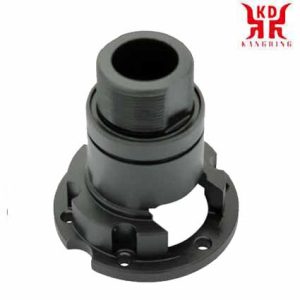
알루미늄 합금의 회전 부품
알루미늄 CNC 가공 공정
알루미늄은 오늘날 사용 가능한 다양한 CNC 공정을 사용하여 가공할 수 있습니다.. We have listed some of these procedures:
선회
In CNC machining processes, the workpiece rotates while the single-point cutting tool remains stationary along its axis. Depending on the machine used, either the workpiece or the cutting tool performs a feed movement in order to remove the material.
Find out more about our CNC turning services.
갈기
Milling processes are the most frequently used methods when machining aluminum components. These methods consist of rotating a multipoint cutting tool along its axis while the workpiece remains stationary along its own axis. The cutting action and subsequent material removal is achieved by a feed movement of the workpiece or the cutting tool, or a combination of both. This movement can take place along several axes.
Find out more about our CNC milling services.
Pocket milling
Pocket milling, also known as pocketing, is a CNC milling method in which a hollow pocket is milled into a component.
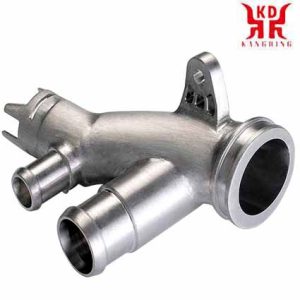
CNC machining of aluminum alloy parts
Face turning and face milling
In machine processing, 깃 달기 / milling is the creation of a flat cross-sectional area on the surface of a workpiece by turning / 갈기.
Drilling
Drilling is the process of creating a hole in a workpiece. In this process, a multi-point rotating cutting tool of a certain size moves in a straight line, perpendicular to the surface to be machined, effectively creating a hole.
Tools for aluminum processing
Many different factors play a role when selecting tools for CNC machining.
Tool design
Different geometry aspects of a tool contribute to the effectiveness in terms of aluminum machining. One of them is the number of cutting edges. In order to avoid difficulties in removing chips at high speeds, the cutting tools for aluminum CNC machining should have 2-3 cutting edges. A higher number of cutting edges leads to smaller chip bays. This causes the large chips of the aluminum alloys to get stuck. When cutting forces are low and chip evacuation is a major concern of the process, two cutting edges should be used. Three cutting edges can be used for the perfect balance between chip evacuation and tool strength.
Helix angle
The helix angle is the angle between the centerline of a tool and a straight tangent line along the cutting edge. While a high helix angle removes chips quickly, this also increases friction and heat generation during machining. This can cause chips to weld to the tool surface during high speed CNC machining of aluminum. A smaller helix angle results in less heat generation, but it may not be able to effectively remove the chips. When machining aluminum, a bevel angle of 35 ° or 40 ° is suitable for rough applications, while an angle of 45 ° is suitable for finishing work.
Clearance angle
The clearance angle is another important factor for the proper function of a tool. An excessively large angle would cause the tool to dig into the component and rattle back and forth. 반면에, angles that are too small can lead to high friction between the tool and the workpiece. Clearance angles between 6 ° and 10 ° are particularly suitable for CNC machining of aluminum.
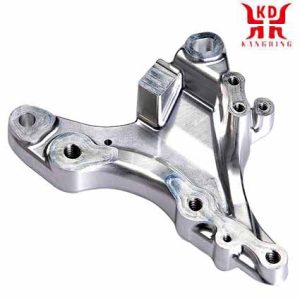
Aluminum die casting
도구 재료
Tungsten carbide is the preferred material for cutting tools used in CNC aluminum machining. Since aluminum is very soft and easy to cut, the decisive factor in a cutting tool for aluminum is not the hardness, but the ability to obtain a razor-sharp edge. This ability is present in cemented carbide tools and depends on two factors, the cemented carbide grain size and the proportion of binder. While a larger grain size results in a harder material, a smaller grain size guarantees a tougher, more impact-resistant material that is exactly the property we need. Smaller grains require cobalt to achieve the fine grain structure and strength of the material.
하지만, cobalt reacts with aluminum at high temperatures and forms a built-up edge made of aluminum on the tool surface. The key is to use a cemented carbide tool with the right amount of cobalt (2-20%) to minimize this reaction while maintaining the required strength. Tungsten carbide tools are generally better suited to withstanding the high speeds of CNC aluminum machining than steel tools. In addition to the tool material, the coating of the tool is an important factor in the cutting efficiency of the tool.
ZrN (zirconium nitride), TiB2 (titanium boride) and diamond-like coatings are some of the suitable tool coatings for CNC machining of aluminum.
Feeds and speeds
The cutting speed is the speed at which the cutting tool rotates. Since aluminum can withstand very high cutting speeds, the cutting speed for aluminum alloys depends on the application limits of the machine used. As with CNC aluminum machining, 속도는 최대한 높아야 한다, 이렇게 하면 구성인선의 위험이 줄어들기 때문입니다., 시간을 절약하다, 부품의 온도 상승을 최소화합니다., 칩 브레이킹을 개선하고 표면 조도를 향상시킵니다.. 정확한 작업 속도는 알루미늄 합금과 공구 직경에 따라 다릅니다..
피드는 공구가 1회전할 때 공작물이나 공구가 이동하는 거리입니다.. 사용되는 이송 속도는 원하는 표면 조도에 따라 달라집니다., 공작물의 강도와 강성. 거친 절단에는 다음의 피드가 필요합니다. 0.15 에게 2.03 mm / 신부님, 마무리 작업에는 다음의 피드가 필요합니다. 0.05 에게 0.15 mm / 신부님.
냉각 윤활제
가공성이 좋음에도 불구하고, 알루미늄은 건조된 상태로 절단하면 구성인선 형성이 촉진되므로 절대 건조해서는 안 됩니다.. 알루미늄 CNC 가공에 적합한 냉각 윤활제는 수용성 오일 에멀젼과 미네랄 오일입니다.. Avoid cooling lubricants that contain chlorine or active sulfur, as these elements pickle aluminum. You can find out more about cooling lubricants here.
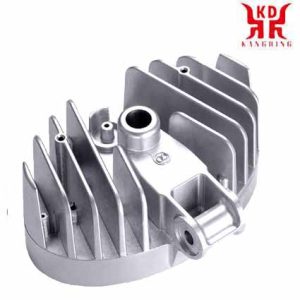
CNC machining aluminum alloy cavity
Post-processing processes
After machining an aluminum part, there are certain processes that can be carried out to improve the physical, mechanical and aesthetic properties of the part. The most common methods are listed below.
Pearl blasting – compressed air blasting with solid abrasive
Bead blasting is a finishing process for aesthetic purposes. In this process, the manufactured component is blasted with a strong jet of compressed air and tiny glass beads, which effectively removes the material and ensures a smooth surface. It gives aluminum a satin or matt surface. The most important process parameters for bead blasting are the size of the glass beads and the strength of the air pressure used. Use this procedure only when the dimensional tolerances of the part are not critical.
Other finishing processes are polishing and painting.
Coating
In this process, the aluminum workpiece is coated with another material, for example zinc, nickel or chromium. This is done to improve the functionality of the component and can be achieved through electrochemical processes.
Anodizing
The anodizing process is an electrochemical process in which the aluminum workpiece is placed in a solution of sulfuric acid. An electrical voltage is then applied between the anode and cathode. This process converts the exposed surfaces of the workpiece into an electrically non-reactive aluminum oxide coating. The density and thickness of the coating depends on the composition of the solution, the duration of the anodizing process and the electrical current applied. Anodizing can also be used to color the component.

Aluminum profile
Powder coating
In the powder coating process, the component is coated with a colored polymer powder using an electrostatic spray gun. The part is then cured at a temperature of 200 ℃. The powder coating improves strength and resistance to wear, corrosion and impact.
열처리
Components made from heat-treatable aluminum alloys can be subjected to a heat treatment to improve their mechanical properties.
Applications of CNC-manufactured aluminum components in industry
위에서 언급했듯이, aluminum alloys have a number of advantageous properties. This is why CNC-manufactured aluminum components are indispensable in many branches of industry, including:
Aerospace: Due to the high strength-to-weight ratio, many aircraft fittings are made of aluminum.
Automotive industry: similar to the aerospace industry, many components such as axles and other components are made of aluminum.
Electronics: Due to their high electrical conductivity, CNC-manufactured aluminum components are often used as electrical components in electrical devices.
Food and pharmaceutical industry: Since aluminum does not react with most organic substances, aluminum components play an important role in the food and pharmaceutical industries.
Sports: Aluminum is widely used to make sports equipment such as baseball bats and whistles.
Low-temperature technology: Due to the ability of aluminum to maintain its mechanical properties even at temperatures below zero, aluminum components are often used in low-temperature applications.
 English
English العربية
العربية 中文(漢字)
中文(漢字) Čeština
Čeština Dansk
Dansk Nederlands
Nederlands Suomi
Suomi Français
Français Deutsch
Deutsch Italiano
Italiano 日本語
日本語 ಕನ್ನಡ
ಕನ್ನಡ 한국어
한국어 Português
Português Русский
Русский Slovenčina
Slovenčina Español
Español Svenska
Svenska Türkçe
Türkçe

